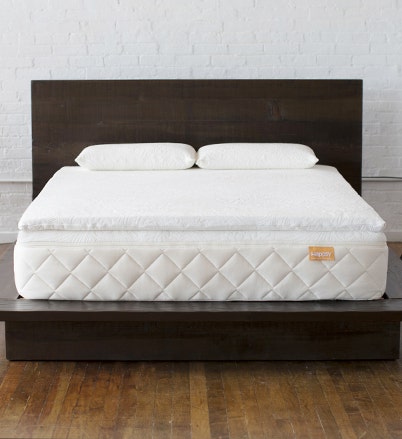
In the 1970s, the bedding industry and the U.S. Consumer Product Safety Commission teamed up to create federal standards for mattress flammability. Since then, while the federal regulation itself has changed a bit, the result has remained the same – every mattress sold in the U.S. must pass the exact same federally mandated flammability standards.
This is great for our safety … right? On one hand, yes. Knowing that your mattress won’t quickly go up in flames in the event of a fire may help you sleep a little better at night – pun intended!
But on the other hand, the methods that many conventional mattress companies use to pass this federally mandated flammability test range from questionable to toxic. This includes, of course, flame retardant chemicals and barriers. Let’s dig in.
Are flame retardants necessary … really?
In order to meet flammability standards, the majority of mattress manufacturers will coat, cover, soak or douse their mattress fabrics in chemicals. Harmful chemicals. Known as flame retardants, these chemicals and chemical barriers are the culprits behind all sorts of health and developmental concerns.
But, isn’t it a fair trade-off? Without flame retardants, wouldn’t a mattress become more flammable and thus unsafe? The surprising answer is no.
The reason most mattresses require flame retardants in the first place is because conventional materials such as memory foam burn, burn fast and burn hot. Really hot. But adding flame retardant chemicals is just solving one problem with another … and the solution isn’t even very effective at the job!
The truth is that flame retardants only slow the spread of fire by a few seconds, per Green Science Policy Institute. On top of that, they release toxic carbon monoxide and hydrogen cyanide when they burn. Inhalation of these chemicals is the cause of the vast majority of death by fire, both to residents and firefighters – not the flames themselves.




The Happsy solution to fire protection
At Happsy, we are fully against the use of flame-retardant chemicals and our mattresses are still fire-safe, passing all of the government flammability standards, easy-peasy.
We consider the best form of fire protection to be our superior product design, which eliminates the need for these toxic chemicals in the first place. Organic cotton, for example, is a far superior filling material that’s significantly less flammable. Using higher quality materials with slower burn times and lower burn temps reduces the need for flame retardants at all.
4 Questionable ways to meet flammability standards
Unfortunately, not all mattress companies follow the same organic guidelines that we do here at Happsy. In particular, manufacturers that use petroleum-based fill materials such as polyurethane foam (like memory foam) are working with extremely flammable substances. These types of mattresses cheaply and easily pass fire safety tests by being infused with chemical flame retardants. And because it’s cheap and easy, that’s what most mattress manufacturers do.
And on top of it all, these companies aren’t required to tell you how they pass fire safety tests or which chemicals they use to do so. You spend a third of your life sleeping, and you deserve to know just what you’re sleeping on. Let’s shed some light on the common (and problematic) approaches that many mattress companies take to passing flammability standards.
1. Toxic chemicals
The original approach to passing flammability requirements was to treat the actual foam with flame-retardant chemicals. Unfortunately, this method is still common today … and is arguably the one with the most potential for harm.
This is because it requires toxic chemicals that can off-gas from the foam into the air in our homes. Exposure to flame-retardant chemicals has been linked to health risks including:
- Cancer
- Endocrine disruption
- Cardiovascular disease
- Cognitive delays
- Decreased fertility
2. Fire-retardant covers
An alternative method to fireproofing mattresses is to encase the flammable materials in a synthetic fabric sleeve or barrier. Sounds great, right? Not when you realize that flame-retardant chemicals are typically mixed into the composition of the fabric sleeve – you know, the sleeve that’s intended to replace flame retardant chemicals.
Mattress companies will promote the use of “inherently flame-resistant fabrics” instead of flame retardant chemicals. However, the chemicals are still there – just better hidden.
3. The fiberglass “solution”
Fiberglass is used in mattresses as a cheap flame retardant alternative. When used as a flame barrier, fiberglass causes mattresses to melt rather than to burn, slowing the spread of fire. But notice that we said it was cheaper … not healthier.
If your mattress cover is compromised, fiberglass fibers can escape and wreak havoc on your home and your health. Risks associated with fiberglass exposure include:
- Rashes and blisters when touched
- Eye irritation
- Lung irritation
- Worsened asthma
Not only is fiberglass harmful for your health, but it can hurt your wallet, too – once fiberglass is released into the home, it is impossible to remove without a professional.


4. When in doubt, lie
The truth is, you can’t take a flammable foam block and make it pass fire-safety tests without using some sort of chemical treatment. It just doesn’t work.
So, when polyurethane foam mattress manufacturers claim to have a 100% natural fire barrier, such as silica, it’s simply not true. Those hydrated, silica fire barriers are actually rayon – a synthetic fiber that’s anything but natural.
How does Happsy pass flammability tests?


It’s actually quite simple. For one, we don’t use petroleum-based polyurethane foam in our certified organic mattress. It’s much easier to avoid flame-retardant chemicals if you don’t use a block of solid fuel as your primary material.
Doing away with polyurethane foam helps, but that alone isn’t enough. This is why we’ve created an innovative, naturally flame-resistant design. Through extensive research and testing, we’ve made sure that all of our organic materials pass fire safety tests with absolutely no chemical flame retardants or barriers. There’s nothing soaked into any foams or coated onto any fabrics.
For Happsy, avoiding highly flammable polyurethane foam was always a no-brainer. Why make a mattress out of petroleum-based material when you can use organic cotton, wool and latex and glue-less encased coils? Better materials mean better sleep! And that’s what we’re here for. We want you to sleep easy, knowing you don’t need to worry about flame-retardant chemicals in your mattress – so that you can Sleep Healthy, Wake Happy™.





